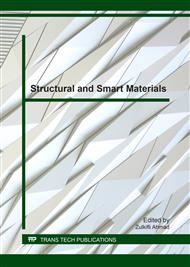[1]
Yi H L, Ding X. On the representation of multi-layer woven structure[J]. Journal of Donghua University, 1999 (3): 14-16.
Google Scholar
[2]
Rudd C D, Long A C, Kendall K N, et al. Liquid moulding technologies. Woodhead, Cambridge, 1997, 231.
Google Scholar
[3]
Potluri P, Sagar T V. Compaction modelling of textile preforms for composite structures[J]. Composite Structures, 2008, 86(1): 177-185.
DOI: 10.1016/j.compstruct.2008.03.019
Google Scholar
[4]
Nguyen Q T, Vidal-Sallé E, Boisse P, et al. Mesoscopic scale analyses of textile composite reinforcement compaction[J]. Composites Part B: Engineering, 2013, 44(1): 231-241.
DOI: 10.1016/j.compositesb.2012.05.028
Google Scholar
[5]
Batch G L, Cumiskey S, Macosko C W. Compaction of fiber reinforcements[J]. Polymer composites, 2002, 23(3): 307-318.
DOI: 10.1002/pc.10433
Google Scholar
[6]
Xie Y, Li S, Chen L. Experimental research on compression characteristics of 2. 5D woven fabric [J]. Journal of Tianjin Polytechnic University, 2010, 3: 19-23.
Google Scholar
[7]
Lu Z, Zhou Y, Yang Z, et al. Multi-scale finite element analysis of 2. 5D woven fabric composites under on-axis and off-axis tension[J]. Computational Materials Science, 2013, 79: 485-494.
DOI: 10.1016/j.commatsci.2013.07.003
Google Scholar
[8]
Green S D, Long A C, El Said B S F, et al. Numerical modelling of 3D woven preform deformations[J]. Composite Structures, 2014, 108: 747-756.
DOI: 10.1016/j.compstruct.2013.10.015
Google Scholar
[9]
Zhou C, Yu J, Zhou G. Micro beam model for 3D woven composite materials[J]. Acta Materiae Compositae Sinica, 2004, 6: 155-160.
Google Scholar
[10]
Zhou G, Wang X, et al. Mechanical model and experimental verifications of 3D woven composites [J]. Journal of Nanjing University of Aeronautics & Astronautics, 2004, 4: 007.
Google Scholar
[11]
Gorczyca-Cole J L, Sherwood J A, Chen J. A friction model for thermostamping commingled glass–polypropylene woven fabrics[J]. Composites Part A: Applied Science and Manufacturing, 2007, 38(2): 393-406.
DOI: 10.1016/j.compositesa.2006.03.006
Google Scholar
[12]
Xia Z, Zhang Y, Ellyin F. A unified periodical boundary conditions for representative volume elements of composites and applications[J]. International Journal of Solids and Structures, 2003, 40(8): 1907-(1921).
DOI: 10.1016/s0020-7683(03)00024-6
Google Scholar
[13]
Tan P, Tong L, Steven G P. Modeling approaches for 3D orthogonal woven composites[J]. Journal of Reinforced Plastics and Composites, 1998, 17(6): 545-577.
DOI: 10.1177/073168449801700605
Google Scholar


